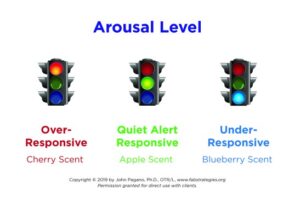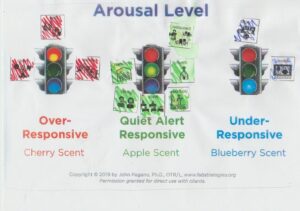The FAB Arousal Level strategy helps children and teens with complex behavior challenges become aware of their arousal. Using traffic lights and smells youth are gradually guided towards an awareness of their current arousal level. While I like both the Zones of Regulation and Alert Program I find severely disabled youth can be confused by their terminology and mix the two approaches up. The FAB Arousal Level strategy is consistent with and can be used along with the curriculum of both of these proven programs to help youth with severe intellectual and/or trauma disorders.

The cherry smelling red light is an over-responsive state where they may hit or bite others. The green light accompanied by an apple scent is a calm alert state optimal for learning. The blue light special with blueberry scent is an under-responsive state when many youth isolate themselves, avoid others, won’t go to school, and may engage in self-injurious behavior “just to feel something” or to avoid recurring negative thoughts.
Initially therapists and teachers will have to coach youth regarding the situations, body feelings, and actions that signal these 3 distinct arousal levels. The youth’s family, therapists, and teachers must use a consistent approach with the child or teen to help them them find the individualized strategies to move towards a quiet alert state. (I think a calm alert state may better describe the green light apple scent, although I used the traditional school term “quiet alert state” I don’t mean the youth need to be silent). Finally, youth are taught to distinguish the environmental social variables to consider when monitoring arousal levels.

I’ve purchased both the Alert Program and Zones of Regulation materials to help youth with complex behavior challenges. I use them in conjunction with my FAB Arousal Level strategy for kids who need a more basic method to enhance or integrate those approaches. I find some youth who have been taught both methods and are too rigid to combine them. I offer my copyrighted FAB Arousal Level approach for teachers and therapists to use to help their students.
